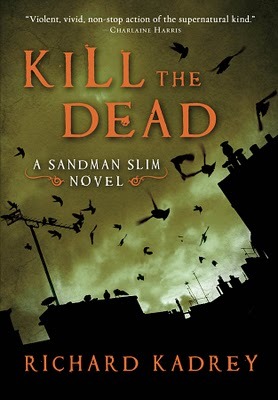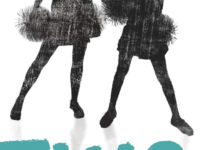
What if they threw a zombie outbreak and nobody cared? Sure, there are people dying in the streets, but they're just humans. They don't even know how to do magic? Who gives a damn about them?
That seems to be the concept of Kill the Dead, a book almost wholly lacking in the human element. Every character is above the mass slaughter of the citizens of their surrounds, because they've got bigger problems elsewhere: Heaven and Hell are far more important than the concerns of 4 million people in danger of being eaten.
Kill the Dead kicks off six months after Sandman Slim, and our titular hero (real name James Stark) comes off a six month bender of depression so that he can be Lucifer's bodyguard while the big man is making a biopic. The disappearance of members of influential magical families also bears investigations, and the deeper Stark gets the more ghoulish the case becomes.
Kill the Dead seems a natural evolution from Sandman Slim, and it cuts fewer corners. That simple tale of revenge is now replaced by a slightly more complex detective story, albeit one with a detective too hot headed and impulsive to effectively think his way through a case. Stark's largest problem as a character in the first book was that he was practically indestructible and consequently took stupid risks.
The six month time break has allowed some of his literal, physical humanity to be restored. That Stark has to be more careful is a relief to the reader sick of recklessness without consequence, and that he may be losing his demonic scars and all they entail are a cause of great worry to the character himself.
The detective aspect of the story works because Stark needs more external help than he realises, and his interactions with several key characters are entertaining. Kadrey has written Lucifer very well, and Stark is a good offsider for him. Lucifer doesn't feature near as much as you would want or expect, but the man needs to maintain some of his mystique. Kadrey is probably going to be accused of being a Satanist or something, but the relatively balanced and sympathetic portrayal of the Prince of Darkness allows for much more nuance than one might otherwise have expected. In a thoroughly unrealistic portrayal of the movie making machine, Lucifer stands out as the most authentic element. It will be interesting to see if God Himself will show up when Stark makes his inevitable(?) ascent to Heaven, and this is one of the reasons I will continue to keep tickets on this series.
Stark's own offsider, the talking severed head on a plate, Kasabian, brings the most warmth and normality to the book. When Stark and Kasabian are together, they – and Kadrey – fall into a comfortable routine that feels more real than anything else presented in the work. Keep in mind we're talking about a head that gets about on mechanical legs like one of Sid's inventions from Toy Story. He eats and drinks over a bucket, for something's sake, but the dynamic Kadrey has written between the two is welcome amidst all of the misanthropy going on elsewhere. Their friendly bickering, planning and discussions of Hell's politics make the book shine in ways that it does not even attempt elsewhere.
Other characters don't fare quite so well: you need to have read Sandman Slim for this book to make much sense in the first place, and you have to have it fairly fresh in your mind for the characters of Kinski and Candy to be more than cardboard cut outs. They suffer from being "off camera†for the majority of the book, and so there is no weight to back up their eventual importance to the plot. Porn star and zombie hunter Brigitte Bardot (yeahhhh) is little more than a distraction and an excuse for Kadrey to attempt a sex scene, and Vidocq and Allegra are little more than ancillary characters this time around.
Outside of Slim's friends, the more villainous characters are well represented. The overall plot is developed satisfactorily, if not in great depth, and motivation is not an issue. Some of the more surprising actions justified the entire enterprise, if only because they promise to pay off later.
The book is far from perfect: a zombie infestation is fairly worthless without humans. As a backdrop to the book's biggest, most surprising and enjoyable reveal, they're fine. Otherwise, the city of LA is just ants chasing other ants and consuming them. Nobody cares about ants unless they're Dave Foley and/or Woody Allen.
Kill the Dead will consequently never become an exemplifier of the zombie genre, but one of the few scenes where Stark actually has to deal with them in a meaningful fashion does great things to Kadrey's writing. The presentation of the first person narrative changes and fights itself as Stark's priorities rearrange themselves, almost against his will, and the inner turmoil revitalises a character in grave danger of stagnating under the weight of his own cool detachment; novelties hungover from the first book, such as constant car theft, the accompanying self-righteousness, and clothing destruction, get old quickly, after all.
Rather like Sandman Slim, the best parts of Kill the Dead are those that set up for the next book in the series. This is unfortunate, because the legitimate energy and excitement generated by the passages promising cool things on the horizon should really have translated across to the main body of the text – something that only happens once (it is legitimately well worth it, though). Descriptions of the politicking and impending war in Hell, and the promise that one day we might get to see Heaven, keep me looking onward and upward, but one day Kadrey is going to have to deliver on his promises.
It is clear by the end of Kill the Dead that Earth is a necessary, if bland, evil. When Kadrey cuts loose and finally shows us the realms of the angels and the fallen, we'll end up with something more than deliberately pulpy “noir” – something that has earned its place in the theologically inspired fiction canon.


